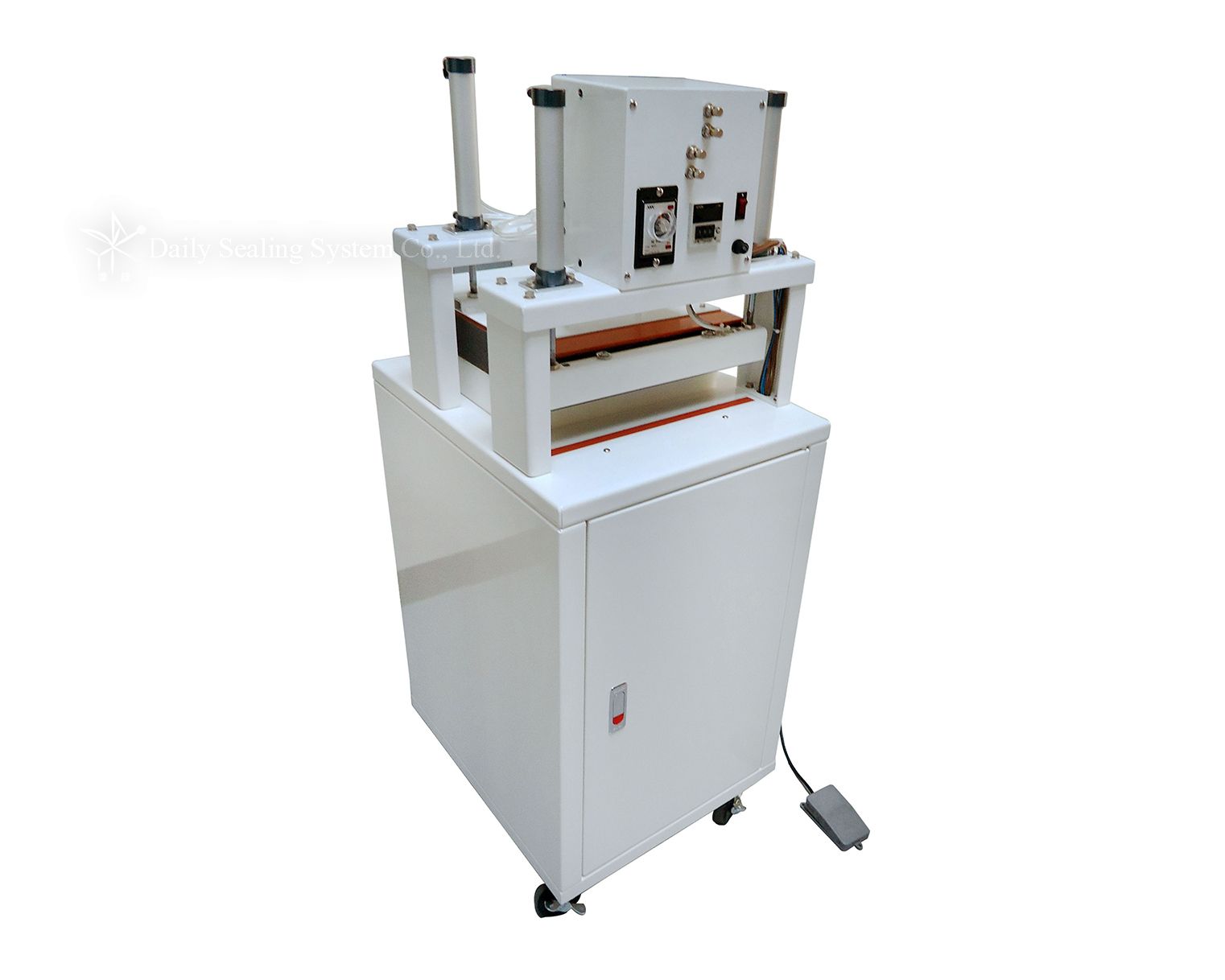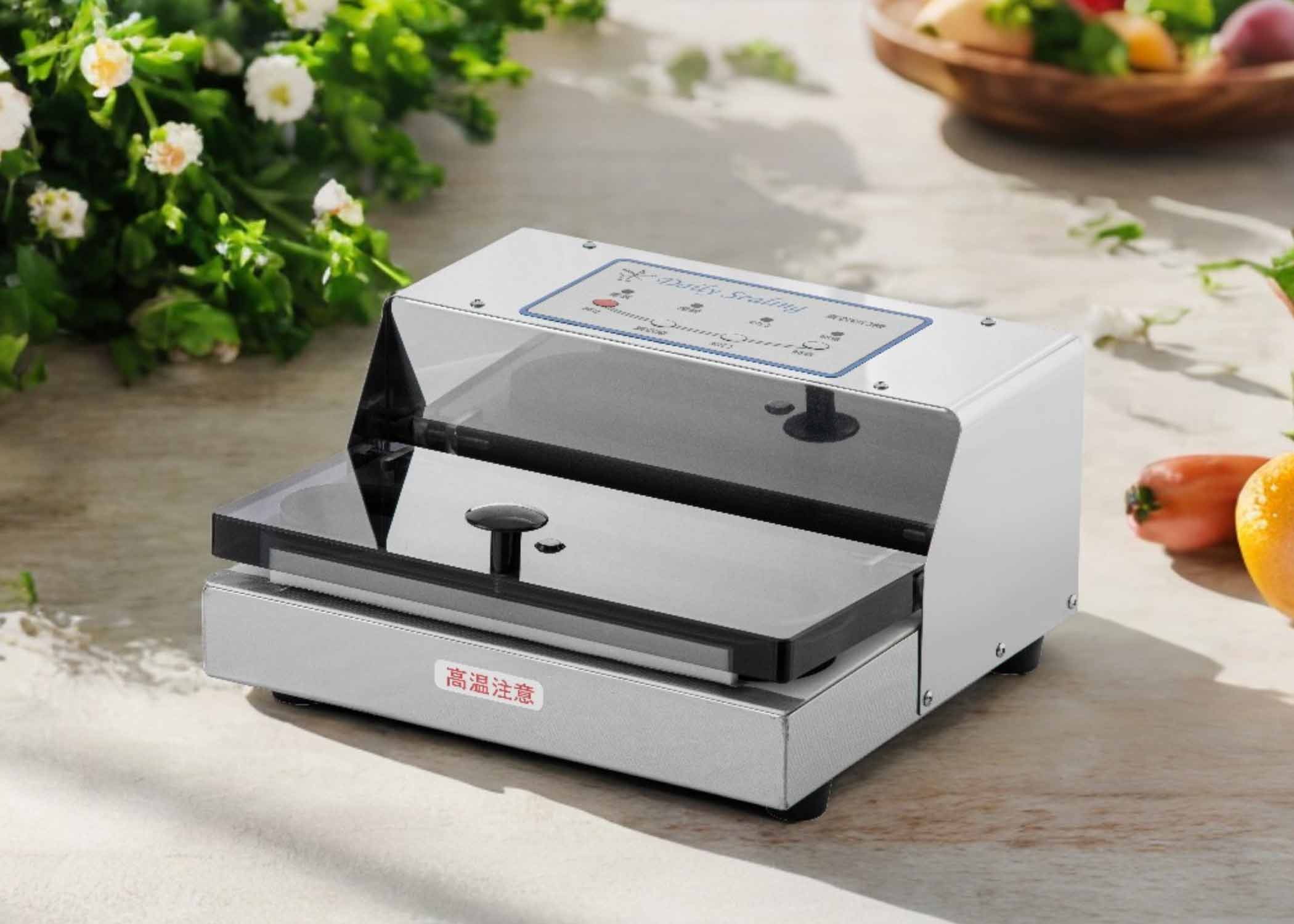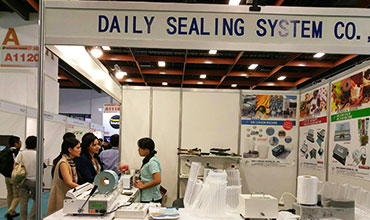After the machine is started, the package is pressed first, and the air is squeezed out before sealing.


- Detail
- Video
Pneumatic control constant heat sealer:
• Machine: made of metal plate coating, keeps hygiene and safety
• Heating line: offering mesh or straight-line texture.
• Temperature control:Thermostatic control, as per package material and degree of thickness to adjust increasing temperature for good sealing quality steadily.
• Pneumatic pedal switch control: easy operation, gives consistent and trim result every time.
• Equipped 4 wheels to move it easily.
• Available for: aluminum, tinfoil, KOP, antiseptic bag, vacuum nylon bag.
Specification
| Model No. | DC4-350DR |
|---|---|
| Voltage/Ampere | 110V, 220V / 1.4A |
| Power | 310W(220V) |
| Max.sealing | 350.0 x 10.0 mm |
| Sealing time | 0.0–6.0 sec. |
| Machine weight | 56.00 kgs |
| Machine size | 450 x 570 x 1200 mm |
| Sealing Temperate | 0 - 399℃ |
Pneumatic control constant heat sealer:
Why Choosing Dailysealing
Parts and material quality control
- Heating elements are from Japan.
- Motor, Transformers, PCB and vacuum bags are made in Taiwan.

Strict quality control
- 100% product inspection: The inspection is included functions and appearance of sealing machines.
- Tensile strength test to ensure the sealing line tensile strength value reaches the customer standard.
- Electric leakage test: Puncture and insulation test.
- Our production and inspection are all based on ISO 9001.

Professional packaging and sealing machine factory
- Produce many kinds sealing machines and ODM/OEM products and provide custom-made services.
- More than 30 year experiences in packaging machines industry.
- Sell sealing machines to America, Europe, Latin America and Asia.
- 85% products in stocks, so we can deliver the products quickly.
- The production process is based on SOP to ensure the quality of sealing machines consistently.

Complete range of specifications of sealing machines
- Complete range of specifications of sealing machines.
- Many kinds of sealing machines and consumptive materials in stocks, so customers can do one-stop shopping here.
- The customers include Biotechnology companies, Medical equipment companies, Food industry, Electronics industry, Handmade soap industry and other industry..
Custom-made sealing machine service
- Custom-made sealing machine service
- Designs of the special sealing machine for irregular shape sealing line, such as U-shape sealing line and L-shape sealing line.
- Different width of sealing line could be custom-made to meet customer requirements.

After-sales service of professional sealing machine
- Provide the professional service for repair the broken sealing machine immediately.
- The sufficient supply of parts stock, so don’t worry about the parts replace.
- Some parts of sealing machine are used in common specifications, so it is easy to get the parts for replace.

Exhibitions and trade shows
News

2024/12/24
How a Vacuum Sealer Works
How a Vacuum Sealer Works Many friends often ask: "Do I have to use a vacuum bag when using a vacuum sealer?" "Do I have to use special bags when using a vacuum sealer? Can I use flat vacuum bags with non-nozzle type vacuum sealers? Can I use all type
vacuum bags with chamber vacuum sealers?" You can find the answer after reading the following instructions. 1. Do we have to use vacuum bags for vacuuming? A: If you only want to remove air, any material can be used. But if you want to maintain the vacuum
state for a long time, you must use vacuum bags which are PA (Nylon) material or aluminum foil bags with high airtightness. 2.Does "vacuum" really mean making the bag completely free of gas inside? A: Actually not, the main principle is to reduce the air
inside the bag to a level where microorganisms cannot survive, reducing oxidation or product spoilage, keeping items less susceptible to rusting, and maintaining the freshness and shelf life of food inside the bag. 3.Differences in principles between Non-nozzle
vacuum sealer and chamber vacuum sealer. A: There are two different principles of air extraction, which also lead to different advantages and disadvantages. (1) Non-nozzle vacuum sealer: Directly extract the air from the bag, and then use heating to melt and
seal the plastic bag. Therefore, if you want to package fluids or powders, Non-nozzle vacuum sealers are likely to extract the contents you want to package, or extract contents that should contain moisture. Sometimes it may even cause internal parts to get
wet and be damaged. Most of the vacuum bags seen on the market have patterns on them, which is because most vacuum sealing machines are direct air suction type. When sealing wet items with this type of vacuum packaging machine, it is necessary to form channels
for smooth air. These channels are the patterns or folds on the vacuum bags or aluminum foil bags commonly seen in the market. When the air in the bag is reduced, aerobic bacteria cannot survive, so the items can be preserved for a longer period of time. Therefore,
whether it is a grid pattern, diamond pattern, or the vacuum channel sealer bags made by our company, they are all designed to facilitate air flow. Therefore, we would recommend using non-nozzle vacuum sealers for items with less water content and larger particles
inside. (2) Chamber vacuum sealer: When the lid is closed, the motor begins to perform the vacuuming action. At this time, the air inside the vacuum chamber and inside the vacuum bag will be affected by the motor and flow, so the pressure inside the vacuum
chamber will gradually become negative pressure. At this time, we may observe a phenomenon where the vacuum bag we placed inside is expanded. This is because the speed at which the air is removed from the vacuum bag cannot be as fast as that in the vacuum
chamber, which causes the pressure inside the bag to be greater than other parts of the vacuum chamber in a short time. This phenomenon will also cause the air inside the bag to accelerate and leave the bag at the moment the solenoid valve operates, and at
the same time, the heating plate will heat and seal the bag. Since it does not directly vacuum the air out of the bag, there is no need to worry about the moisture inside the bag being drawn out. For items with liquid or powder content, we would recommend
using a chamber vacuum sealer. Because the air inside the vacuum chamber is vacuumed out, the bag does not need an additional air extraction duct, so it can be used without embossed vacuum bags. 表單的頂端 表單的底部表單的頂端
MORE

2025/1/8
2025 Chinese New Year Festival
Dear Sirs, By government guidelines on the Lunar New Year Festival, Daily Sealing will be closed for a vacation break from January 25 to February 02, 2025. We are very grateful for your patronage and collaboration in the past year, and would like to take
this wonderful opportunity to wish you Happy New Year of The Snake Yours truly, Daily Sealing System Co., Ltd.
MORE

2023/4/28
How to choose a suitable sealing machine? (Impulse heat sealer vs. constant heat sealer)
Various types of sealers on the market have different features and operating methods, how to choose a sealing machine that is easy to use and suitable for you. The following are divided into two types according to the heating method of the sealing machine:
Impulse heat sealers and Constant heat sealers are introduced. Impulse heat sealers can set sealing time to heat. When the operator presses the handle to touch the micro switch, heating element will be heated and when reaching the set sealing time, power
off automatically, the heating element is no longer heating. The impulse heat sealer can be divided into single heating and double heating. The applicable materials are as follows: Single heating: plastic bags, such as PE, PP, non-woven bags etc. Double heating:
aluminum foils gusset bags (such as tea bags), vacuum bags, sterilization bags, and thick bags. The width of the heating element of the impulse heat sealer is divided into 2mm/2.7mm, 5mm and 10mm. If you want to fuse without leaving an edge, you need
to choose a round wire: 0.6mm/0.8mm. Consumables for Impulse heat sealer include heating element, Teflon cloth, and Teflon tape. Different types of sealing machine, such as hand type sealers and foot type sealers, use the different size Teflon tape or Teflon
cloth. Please ask for details of consumables when purchasing. Tips: 1. Different bags require different heating time. We suggest the users set the short time in the beginning. If the sealing line is not complete, the user can set a little longer sealing
time. Please don’t set the maximum sealing time in the beginning. If the sealing time is too long, the bags will be melted. It will also shorten the life of the heating element. If the sealing line melts, please decrease the sealing time. 2. When the
sealing time of the sealing machine reach the target time (the red light is off), stay for a few seconds for the cooling time and then release the handle, the sealing line will be beautiful and complete. 3. If the heating light indictor is on, but the
heating element can't heat up. Please check the heating element, maybe the heating wire is broken. The user can take off the Teflon cloth first to check the heating element. If the Teflon cloth is burnt black, even burned, please replace the Teflon cloth.
If the user doesn’t change the new one, it might make the heating element broken fast. Constant heat sealer is temperature controlled sealing machine. After turning on the power, it needs to warm up for 5-10 minutes. When the temperature of the sealing
seat reaches the set temperature, it will maintain constant temperature. Constant heat sealers use heating tubes or heating plates for heating. Because the heating bars maintain the high temperature, be careful when operating the constant heat sealers. Please
don't touch the heating bar to avoid burns. There are three patterns of sealing line: net pattern (cross pattern), stripes pattern, and flat pattern. More people choose cross patterns. The constant heat sealer is available for aluminum foil bag, vacuum nylon
bag, tinfoil bag, sterilization bag. Please don’t use the constant heat sealer to seal PE, PP and other plastic material bags. The bags will melt and stick to the heating bar. It will be hard to clean up the heating bar, and might make the sealing line incomplete.
The width sealing line of constant heat sealer is 10mm and 15mm. Tips: The different materials bags are suitable for different temperatures. We suggest the users start to seal the bags by low temperature. If the sealing line is not complete, it means the
temperature is not enough, please set a little higher temperature. If the sealing line melts, indicates the temperature is too high, please turn down the temperature. When the users adjust the higher or lower temperature, please wait the few seconds to let
the current temperature to reach the setting temperature.
MORE








